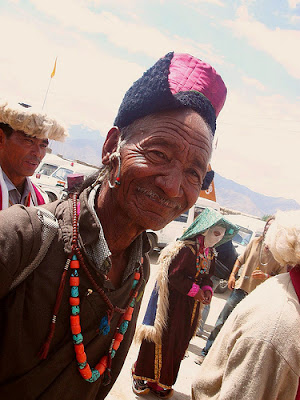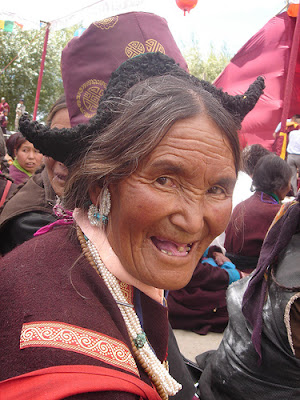wrinkles in time
Leh, LadakhI just came from the Jamma Masjid ("Friday Mosque") in the main square of downtown Leh.

Friday is the best time to take photos, because it's the special day for Muslim prayers.
I love the way identities are so confusing in Ladakh. People who "look Muslim" turn out to be Buddhist and vice versa. It totally messes with my preconceptions.
My favourites are the old-timers with ravine-filled faces and traditional clothing. When I was much younger, I used to hear people describe the elderly as "beautiful" and thought "yeah right, who would really want to look like that? They are just being polite...."
But now I really find it hard to take interest in photographing most younger people. The older people really are more beautiful.
This afternoon at 1.30 prayers, I was only able to photograph men. (Women generally pray in the home, at least in this area.) I haven't been able to upload today's photos of the old timers yet. So here are some more wonderful Ladakhi faces with the invariable Ladakhi smile.
Can you believe I've never been to the Taj Mahal?I can't.
After all these years in India, I have been to so many places... but still not the Taj Mahal, definitely the most famous UNESCO World Heritage site in India,

if not the whole world.
While browsing
the UNESCO website (looking for information about protected rock carvings - the ASI director for Leh swears that such things are not protected by UNESCO, which of course, is not true) - I decided to list all the World Heritage sites I
have visited.
Tamil Nadu:Brihadeshwar Temple
Mahabalipuram monuments including the "Shore Temple"
Maharahstra:Ellora Caves
Ajanta Caves
Victoria Terminus (recently renamed "Chhatrapati Shivaji Terminus," which peeves me, because Queen Victoria's people built it....it has nothing to do with Shivaji, he was dead a long time before this building was erected; why should he get credit?)
Bihar:
Mahabodhi Temple
Delhi:The Red Fort
Nepal:Pashupatinath Temple (foreigners not allowed inside..but they want your money anyway)
Kathmandu Durbar Square (foreigners not allowed in Kumari Ghar or most temples. They still hit you up for entrance fees. Somehow they have it worked out that this makes sense)
Patan Durbar Square (same policy - foreigners not allowed inside temples. Indians, who technically are foreign, are allowed - just not white people)
Bhaktapur Durbar Square (same - foreigners not allowed inside temples)
Boudhanath Stupa
Swayambunath Stupa
Changu Narayan Temple
I have consistently lodged my own one-woman protest at the discriminatory Nepali sites, by never, ever paying the price for buildings I'm not allowed into. (Makes perfect sense to me.) Instead, I have enjoyed the surrounding areas without paying, and now know all the secret back entrances to each of the sites. Write me for details. I don't support places that claim to represent the heritage of
"all the peoples of the world, irrespective of the territory on which they are located," and then discriminate based on race. I welcome you do the same.
All the other places listed do charge more for foreigners, but at least the access is equal for all. If I'm going to pay five times as much, I should be able to see the place - that seems more than fair.
The Bus Is Back
Good news, budget Himalayan travellers. The Kathmandu-Lhasa Express is back on the road (as of January).
Too bad the same cannot be said of Nepali politics. Yesterday was originally meant to be the historic elections. It passed without a peep as political infighting continues and fresh violence erupts in the Terai region.
Here's more about the bus:
The bus service ran into trouble soon after its start in 2005 and remained suspended. Though resumed again for a  short period in 2006, it has been closed since spring.
short period in 2006, it has been closed since spring.
Officials in Nepal blame the closure on the Chinese reluctance to issue visas.
Beijing issued visas only to tourists travelling in groups, that too after stringent scrutiny. Travellers had to submit details of their itinerary and accommodation and the bus service was shut down by China on the eve of demonstrations in Tibet or anniversaries of historic days.
The revival of the flagging bus service coincides with the start of the Visit China campaign by Beijing to mark 2008 when it hosts the Olympic Games.
Nepal's state-owned Sajha Yatayat will run the weekly service from Kathmandu, like it did in the past. The pact will be a shot in the arm for the floundering state service, most of whose buses have not been running for over a year after an agitation by employees.
The one-way fare for the three-day trip will be $70.
Full news story here.

















